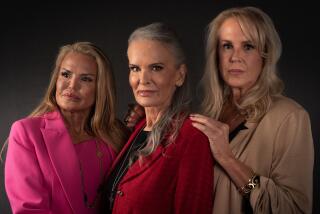THE O.J. SIMPSON MURDER TRIAL : Is the Truth Live or on Videotape?
After watching the great O.J. Simpson glove-fitting event in the courtroom, I went home and viewed the videotape.
God bless technology. Transfixed by the little drama, I was able to watch the tape over and over both in normal speed and in slow motion, repeatedly punching reverse for more replays. I stopped the picture at crucial moments, giving me a chance to use my VCRâs freeze-frame capability.
I was struck by how different the scene had looked to me on television compared to how it had looked in the courtroom.
*
The Timesâ courtroom seat is in the first row, adjacent to the jury box. It was a good place to be as Deputy Dist. Atty. Christopher A. Darden unexpectedly said, âYour Honor, at this time, the people would ask that Mr. Simpson step forward and try on the glove recovered at Bundy as well as the glove recovered at Rockingham.â
These were the gloves that authorities say Simpson wore when he murdered Nicole Simpson and Ron Goldman. All the reporters in the room immediately knew this was a great story. It had the feel of an old Perry Mason drama, when the killer is unmasked on the witness stand.
I started writing in my note pad. I thought of Stephanie Simon, who was writing the main story for The Times, watching the trial on television in the office. She would be able to see Simpson put on the latex gloves and walk toward the jury box, surrounded by attorneys and a sheriffâs deputy. In fact, camera close-ups gave the TV audience a better view of Simpson than I had.
What TV viewers couldnât see was the jury. My job, then, was to watch the jury, to catch the reaction of the 12 jurors and two alternates.
Simpson moved toward the jury box, an imposing figure with his size and athletic saunter, a casual walk that says, âIâm the champ.â He had already put one glove on halfway. The latex underneath was visible. He pulled at it, gripping a corner of the glove.
I wrote in my notebook, âThe jury is bug-eyed. They are really intent.â I recorded how the newest juror, her eyes wide with attention, furiously wrote in her notebook. So did an older man. Others were writing notes, too. I noted each so I could compare them with the brief, nameless descriptions of jurors we had on the wall in the press room.
When the fitting was over, Simpson returned to his seat. I kept watching the jury and noted, âTwo or three minutes afterward, they were still writing notes.â They were fascinated, but I had no idea what they were thinking.
I was aware of other things happening around me. The courtroom, unlike the television screen, is a busy place.
For one thing, there was Dardenâs running critical commentary on Simpsonâs struggles with the gloves. It wasnât so much Dardenâs words as the cutting, sarcastic tone of his voice. His words were distinct in the courtroom. But on television, as I noticed when viewing the videotape later, Dardenâs voice and tone were barely audible and easy to ignore because Simpsonâs hands were such a powerful focal point.
âYour Honor, Mr. Simpson appears to be having a problem placing the glove,â Darden said in a tone that clearly called Simpson a liar. âMr. Simpson is indicating that the fingers arenât all the way into the gloves, Your Honor,â Darden said unbelievingly. Finally, he said: âCould we ask him to straighten his fingers and put them in the gloves as one would normally put them in the gloveâ?
*
I left the courtroom, scrambled to a phone and relayed what I had seen.
My view was shaped not only by watching Simpson, but by hearing Darden and by other sights and sounds of the courtroom. I knew Iâd seen something big, but I wasnât sure how big it was.
When I returned to the office, I saw that my colleagues had stronger opinions than I, based on what they had seen on television. They thought they had watched a turning point in the trial, that the prosecution had suffered a devastating blow. Television had none of the subtleties of the courtroom.
Our story reflected the courtroom, based on what I saw in court as well as what writer Simon had watched on television.
Most of the television analysis I saw Thursday night and Friday morning, however, was based on the stark, simple version of the screen. Thatâs how the majority of commentators saw the event.
The most important audience, the jurors--barred from watching television--will make their judgments from the live performance.
More to Read
The complete guide to home viewing
Get Screen Gab for everything about the TV shows and streaming movies everyoneâs talking about.
You may occasionally receive promotional content from the Los Angeles Times.






